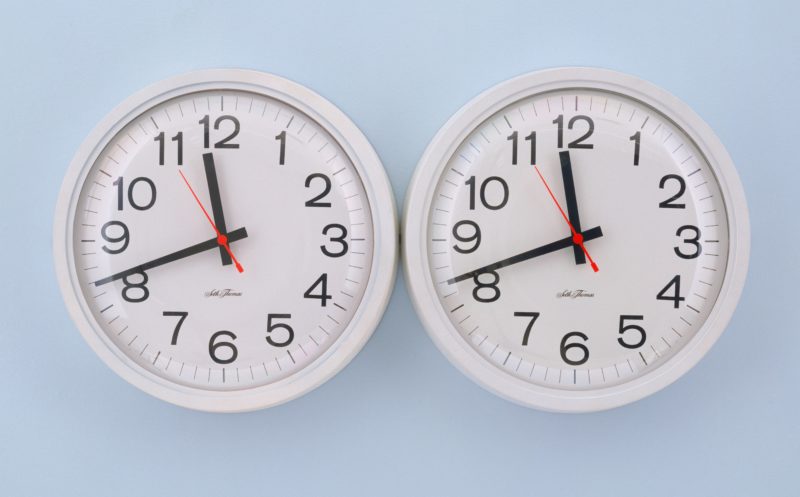
Who was Felix Gonzalez-Torres?
Felix Gonzalez-Torres 1 was a Cuban-born American artist known for his minimal sculptures and installations in which he used day to day materials such as clocks, lightbulbs, stacks of papers, and even packaged hard candies 23.
Many people believe some of his work is a reflection of his experience with AIDS. Felix Gonzalez-Torres was an openly gay artist who thought it was much stronger to consider the homosexual and straight audience as the same and that Cuban-born American is the same as being American.
Perfect Lovers
Untitled (Perfect Lovers) (1991) is one of his famous works. It consists of two clocks that start in synchronization. Slowly and expectedly, they fall out of time. This is caused by running out of batteries as well as the nature of the mechanism.
The meaning
The piece is a moving comment on his private life. It symbolizes the artist’s HIV-positive partner Ross Laycock and his dawdling decline and inevitable death from AIDS. The two clocks represent two mechanical heartbeats, which are illustrative of the two lives ordained to fall out of sync and carry moving poetry about personal loss and the temporal nature of life.
Don’t be afraid of the clocks, they are our time, the time has been so generous to us. We imprinted time with the sweet taste of victory. We conquered fate by meeting at a certain TIME in a certain space. We are a product of the time, therefore we give back credit where it is due: time. We are synchronized, now forever. I love you.
– Felix Gonzalez.

Untitled (Perfect Lovers) also exemplifies the artist’s desire to create artworks that hold multiple interpretations. While the initial reflection is evidently about his own homosexual relationship, the nonfigurative nature of the two clocks’ swap for bodies allows the piece to be read literally as a metaphor for love.
The artist explained how he, more often than not, resisted the label of gay art during the era of extreme censorship and controversy over the NEA funding for Robert Mapplethorpe:
Two clocks side by side are much more threatening to the powers that be than an image of two guys sucking each other’s d@cks because they cannot use me as a rallying point in their battle to erase meaning. It is going to be very difficult for members of Congress to tell their constituents that money is being expended for the promotion of homosexual art when all they have to show are two plugs side by side or two mirrors side by side….
What happens when the batteries die?
Nonetheless, sometimes the batteries die, and it is still possible to replace the batteries and reset the two clocks at the same time.
When the clocks were installed, they were to touch. The two black-rimmed clocks could be, however, replaced with white store-bought clocks with the same dimensions and design. The two hands, minute and second, were to be set in sync with the awareness that the two hands might eventually go out of sync during display. If one of the clocks required battery replacement, it was to be done, after which the clocks were to be reset at the same time. The clocks were to be exhibited against a wall painted in light blue.
Gonzalez-Torres admitted that the clocks would ultimately fall out of synch, and one sooner or later stopping first. Time is something that scares me … or used to. This piece made with the two clocks was the scariest thing I have ever done. I wanted to face it. I wanted those two clocks right in front of me, ticking.
Video: Curator Jasper Sharp on Felix Gonzalez-Torres’s clocks
2 min 28 sec
Analysis
Analysis
Taking a quick look at the two store-bought clocks hanged side by side, there isn’t much that would suggest that this is art. But starting from the title of the piece, we get the first hint, Perfect lovers. Two lovers, standing side by side, ticking in sync.
The second hint comes in the form of instructions on how the two clocks should be displayed. It is a must the two clocks were to touch and could be replaced with white plastic commercial clocks of similar dimensions and design. The guidelines continue, the minute and second hands were to be set in sync, with the understanding that eventually they might go out of sync during the exhibition. If one of the clocks needed the batteries replaced, it was to be done, and the clocks were to be reset accordingly; the clocks were to be displayed on a wall painted light blue.
The guidelines consist of an ambiguous statement: with the understanding that eventually they might go out of sync, if you consider the implication of the phrase perfect lovers, generally or as per those words, perfect love should ideally forever stay synchronized.
However, as much as we worship and espouse this idea in our minds, as we know or should know, the natural state of the universe is to fall towards entropy eventually. Therefore, we understand that the two clocks are destined to drop out of sync in due course.
With Untitled (Perfect Lovers), Gonzalez-Torres brings our attention to another painfully simple metaphor of love and partnership. The two clocks standing side by side reflect a connection between them. They seem to support each other, to be united, to move together as one peacefully. The stillness of the two timepieces, alongside the minimalism of the design and muted solid shades of white, black, and light blue, induce a sense of peace.
Conclusion
The two clocks became a bitter-sweet representation for lovers. First, the piece marks the time when everything between the two perfect lovers is in sync, and simultaneously, it is an aide-mémoire that period of total bliss fades as time passes, and the two lovers move further and further apart. Nevertheless, the two clocks are at all times standing side by side, howbeit after years, they become hours apart.
Gonzalez-Torres oeuvre explores the humanity behind the epidemic of HIV/AIDS. These odes usually use reproducibility and interaction with the audience to interconnect the depth of his love and loss. Untitled (Perfect Lovers) utilizes two ubiquitous objects that are eventually destined to interrupt their perfect harmony.
In this piece, especially, the artist wished to include the audience/viewer as an active agent in producing its meaning. He set private memories and nostalgic journeys into the public domain, expecting to assist viewers in transcending the personal to arrive at a collective experience about the human spirit and social good.
More by Felix Gonzalez-Torres
